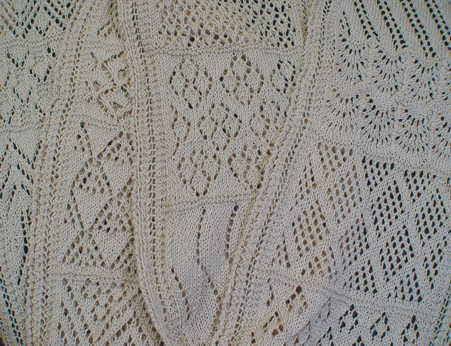In the Bit-size Tutorial You Know More than You Realize, I reminded you of common basic stitches that you probably were already well familiar with. I wanted to point out how this handful of stitches serves as building blocks for a huge portion of lace knitting patterns. It is the combinations and sequence of working these stitches, plus sometimes others, that results in the beautiful lace patterns we admire.
To enjoy the making of these lace stitches ourselves, while preserving the heritage and knowledge to pass them along to future generations, you might come across different ways of documenting and communicating the pattern instructions. I think of the styles of communicating these instructions in 4 broad categories.
Samplers
Samplers have a wonderful history. As explained by Susanne E. Lewis in her book Knitting Lace: A Workshop with Patterns and Projects (page x of Introduction):
“Patterns were rarely published or even written down, particularly in remote communities, because illiteracy was widespread and paper was scarce and expensive. Instead, knitters customarily made samplers to record the patterns.”
Think of samplers as the earliest stitch dictionary reference by which pattern stitches were communicated. It took skill in visually inspecting the piece of actual knitting and translating that to the sequence of stitches to be knit to achieve the same result. If something was done slightly differently, then a variation resulted (either intentionally or unintentionally). Thus further enriching the repertoire of lace patterns passed along to us.

A lace sampler I made based on the original in the Brooklyn Museum that Susanna E. Lewis studied and wrote about in her book
Written Text
A common way of communicating knitting patterns today is written out line by line. Abbreviations may or may not be used to shorten the amount of space taken up by the text in a publication and/or making the instructions easier to read in a glance.
But first, make sure you know exactly what the abbreviations and terms mean in the context of that particular publication — there are no worldwide standards! There should always be a list of abbreviations and any special terminology in the publication somewhere. Take the time to look for it and acquaint yourself with its “language”. This will save you time in making assumptions that can lead in the best case to “interesting” results, or in the worst case to disappointing results.
For example, a single abbreviation/term such as “make 1” can mean different things depending on the publication. Or multiple abbreviations/terms such as “yo” and “yrn” can mean the same thing.
Lace Charts
I think of Lace Charts as the modern-day substitute of the historical samplers. They are similar in that they are a visual representation (to the degree that a chart resembles the resulting pattern stitch).
This method relies on the use of symbols. Each symbol uniquely represents one stitch or stitch sequence in the chart. The symbol graphic may resemble the appearance of the resulting stitch.
Since this month’s Lace Cable Bookmark project introduces knitting lace from charts, I will have much more to say throughout the month about Lace Charts in upcoming Bit-size Tutorials, Tips & Techniques.
Lace Shorthand
A hybrid that I dub “lace shorthand” sort of combines line-by-line written text and symbols. For example, Barbara Abbey devised a “lace shorthand” she used in her book Knitting Lace. To give you a flavor of her lace shorthand, here is Row 8 of an edging pattern on page 98 of the book: 1, /, 0, \, 3, /, 0, 2, f.
I have come across a few other instances of “lace shorthand”, but overall this way of communicating instructions does not seem to be as widely adopted as Written Text and Lace Charts. As always, be sure to take the time to find the place in the publication that explains the “language” and acquaint yourself with it. You might even consider re-writing the shorthand in your own preferred style of instructions to make it simpler, easier, and more enjoyable for you to knit. Taking that bit of time can save you time in the long run.
For Bits of Lace 2012, I will be continuing to offer instructions as written text, as well as Lace Charts for some of the future monthly projects. But I wanted to also give you some of the historical background of samplers, as well as touch on lace shorthand in case you come across something like it elsewhere.


 HeartStrings FiberArts
HeartStrings FiberArts Knitting Bits of Lace on Facebook
Knitting Bits of Lace on Facebook Ravelry Store
Ravelry Store
I knit mainly from charts, although with short or simple patterns, I can read text patterns and not get lost! I also have seen the knitting shorthand used by one particular designer. When I have test knitted patterns, I work from the designers charts. If I find any errors, I use knitting shorthand. Funny how similar mine is to B. Abbey!
My lace shorthand is similar to B. Abbey, except I jot down each line reading from right to left, because I knit from right to left off my lefthand needle. I find this notation much simpler and faster. Usually one glance will establish the ‘picture’ of the repeat in my mind. I use charts too when they suit me, but if I have to translate from written word, I always use the above notation.